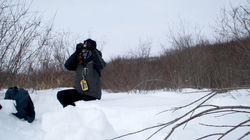Amandine RAMOS, PhD

Behavioural Ecology, Conservation and Wildlife Management
Field Experiences
-
Monts-d'Azur Biological Reserve, Haut-Thorenc (France)
 |
|---|
 |
 |
 |
 |
 |
 |
 |
 |
 |
 |
 |
 |
This field period was carried out from February 2013 to April 2013 and aimed to collect behavioural data about spontaneous collective movements, leadership process, space use and herd habitat selection. Bison being supplemented during winter period, I was also able to take into account the potential influence of articial food patches on movement patterns and activity budget of individuals. The results of this study were the subject of two scientific articles, published in 2015 and 2016.
In addition to my researchs, I had the opportunity to participate to many veterinarian intervertions, wild animals captures and to bison transferts preparation between the european reserves and parks.
My first field study took place in Monts-d'Azur Biological Reserve, at the heart of the Alpes Maritimes (South of France). This reserve of about 700 hectares includes a fenced area of 350 hectares in which a herd of European bison was reintroduce since 2005. The species cohabits with other animal species such as the Przewalski horse, also reintroduced in 2005, roe deer, red deer, boar, red fox as well as many bird species.
-
Prince Albert National Park, Saskatchewan (Canada)
 |
|---|
 |
 |
 |
 |
 |
 |
 |
 |
 |
 |
 |
 |
 |
 |
 |
 |
Another project of my researchs was to study American plains bison in order to compare social behaviour and the leadership process of this species with the European species. These knowledge are interesting not only from a fundamental point of view, but also for the potential applications in conservation and management areas that this knowledge could suggest. Indeed, understanding how a species move and use its territory could help us to developt more efficient management strategies which take into account both species biological imperatives and Human ones. In this context, my main aim was to know if the social organisation of American bison and this of European bison were similar or not for considering the development of common herd management methods.
To answer this question, I went to Canada to follow a plains bison population in Prince Albert National Park (Province of Saskatchewan, Canada). This Park of about 387,000 hectares is home to a very diverse North American fauna such as black bear, grey wolf, elk, white-tailed deer and many others.
The field session was carried out from February 2015 to August 2015. The bison population of Prince Albert National Park is completly free of human intervention (supplemental feeding, fences...). However, during the summer period, individuals invest crops around the park in which they create damages; this situation create conflicts with local farmers and ranchers, context which has motivated these canadian studies.
-
Zuid-Kennemerland National Park, Kraansvlak (The Netherlands)
 |
|---|
 |
 |
 |
 |
 |
 |
 |
 |
 |
 |
 |
 |
 |
 |
 |
 |
 |
To support my conclusions about collective movements and leadership process obtained for the Monts-d'Azur European bison herd, I decided to conduct a second study on an other herd reintroduced in 2007 in Zuid-Kennemerland National Park (The Netherlands). The bison area, named Kraansvlak, is about 330 hectares and is completly fenced in. It is the home of diverse ungulates species such as Konik horses, Highland cattle, red and roe deers, but also micromammals species, from red foxes to rodents, as well as many amphibien and reptil species. The landcape is equally diverse with a large mosaic of habitats, from sand dunes to pine forest by passing throught swamps.
The data collection was carried out from March 2016 to July 2016. Contrary to the Monts-d'Azur herd, the bison of Kraansvlak area are not supplemented by Human; this management choice allowed me to observe more natural behaviours, but also allowed me to compare the results with those of Monts-d'Azur. Because of the small group size (N = 14), the individual recognition has been possible which allowed me to also study the social network of the group and the influence of individual characteristics (e.g. age, dominance, ect...) on leadership process.
Two papers focusing on collective movement mechanisms have been written with one already submitted. The data concerning space use and habitat selection of the herd are being analysed and will be the subject of another article. Finally, fecal samples have been collected to integrate a physiological component to my behavioural study, with the aim of highlighting a specific hormonal and diet profile of individuals identified as leaders. This last study will be the subject of a fourth article.
In addition to my observations, I took part in many vet interventions, census of deer populations, wild animals captures and to bison transferts preparation. I also had the opportunity to participate to several Park events intended to present the Kraansvlak project and researches conducted on the bison herd.